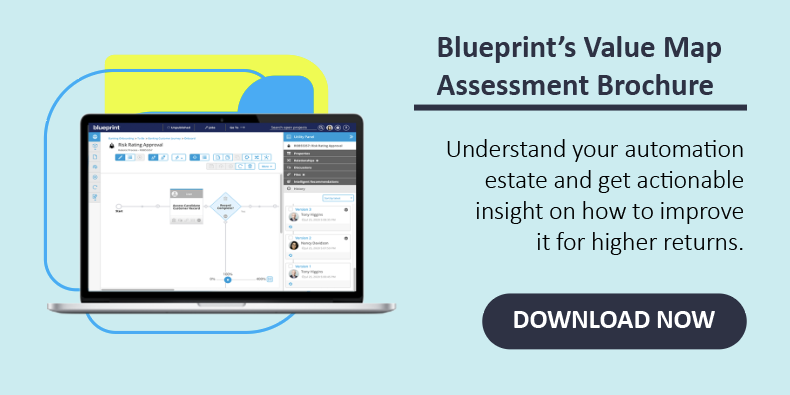Business Process Reengineering: It’s Back and More Important Than Ever
To achieve digital transformation at enterprise scale, team leaders need to reengineer business processes before driving improvement strategies like automation or standardization. Why? Well, attempting to drive digital transformation on top of inefficient or ineffective processes will not only fail, but also expose operational challenges that are difficult to correct once the new and improved processes are in place.
What is Business Process Reengineering and why should you do it?
The aim of Business Process Reengineering (BPR) is to help organizations reimagine their existing processes and redesign them to achieve extraordinary results. When Michael Hammer first introduced this idea, it was to bring attention to business owners that before you can improve the quality of customer service and reduce costs you will likely need to reassess your processes and redesign them to fit the new goals of the business.
BPR allows companies to redesign their processes by enabling cross-functional teams to work together to determine areas of improvement and ways to optimize them for maximum value. In addition, it allows companies to make better decisions through better data dissemination which, as a result, ensures the organization is able to make sound improvements to their customer service. If done correctly, organizations will be able to deploy optimized business processes at a significantly faster rate and reduce costs by getting rid of activities that are unproductive and don’t bring value.
Top 5 Benefits of Business Process Reengineering
A BPR model is a huge undertaking that leaves many business leaders questioning if the payoff is worth it. To help ease your mind, here are the top five benefits of re-engineering your business processes:
- Clarity of Purpose - With the exception of a few high-profile processes that execute in line of business applications and a few compliance-related ones, most organizations cannot describe and have not documented their processes from end-to-end. The first step of any successful BPR implementation is to have a solid grasp on the current state of your business processes to ensure you are automating the right things - if that is your desired output - while reducing the risk for future costly mistakes.
- Simplified and Streamlined Operation - At the end of this entire project, the business is left with a streamlined operation that has cut out superfluous processes (or unnecessary steps in a process) that used to slow things down. By doing this, efforts become more directed towards organizational objectives, employees have a clear path to take, and customers will be much happier with the service they receive.
- Increased Efficiency - By eliminating redundancy in your operations and tweaking processes, things will move through the process more easily and faster, greatly increasing overall efficiency.
- Better Results and Products - Greater efficiency and focused goals enable you and your employees to put more energy towards building relationships with your customers through streamlined, digitized processes. In addition, by building better lines of communicating between cross-functional teams, information is passed through the channels faster, making your business more resilient to market changes.
- Maximized ROI - All of the above benefits together help maximize the ROI on your process improvement investment.
Remember this before you begin...
Heading straight into process improvement strategies like automation risks “embalming” your current operating model. In other words, you risk automating or standardizing inefficient processes. To address this challenge, BPR comes into play to help the organization model the actions and flow of interrelated processes and technologies. Four key things to remember before you begin reengineering processes, as outlined by Forrester’s report Create a Governance Strategy to Meet the Process Imperative:
- Do your research - Most organizations haven’t documented their processes from end-to-end, so before you begin reengineering process you should answer the question: how does my organization operate today? To answer this question, many organizations are turning to process mining, task mining, and task capture tools to help gain a complete view of current processes.
- Work cross-functionally - Nobody knows how the business works better than the businesspeople themselves, so they need to be included in the re-engineering process from beginning to end. A common challenge with including cross-functional stakeholders in a large IT project is that they work in a different language. Luckily, most process discovery tools have the ability to export a model in a standard BPMN format that can then be imported into a tool like Blueprint’s Business Transformation Platform, which enables teams to collaborate on process improvement in a centralized space. Blueprint has its own process discovery solution in Blueprint Task Capture but also integrates with the leading process and task mining tools, making it easier to capture, define, model, and optimize business processes so that teams can ensure their future automations are stable, connected to business outcomes, and resilient to change.
- Ask the experts - Since Michael Hammer introduced the idea of BPR 30 years ago its value has largely remained unrealized. But as organizations have struggled to redesign processes to meet the needs of digital customers, we’ve seen a significant uptick in the importance of process experts. A recent Forrester survey showed that 29% of surveyed organizations plan to increase the role of Lean/Six Sigma to support process improvement and automation, which ultimately indicates an increased focus on process excellence.
- Support the customer and employee journey - A customer journey represents a far more comprehensive experience than any individual process. The customer journey is likely to cross multiple organizational boundaries and a number of business systems and manual processes. Within these journeys, there are often numerous opportunities to improve processes or apply automation to achieve better customer outcomes.
How Blueprint’s Business Transformation Platform Supports Business Process Reengineering
Blueprint’s Business Transformation Platform provides a centralized and collaborative space to capture, design, optimize, and connect all critical information related to how you run your business today so that you can improve for tomorrow.
Blueprint enables teams to extract and ingest existing process data to get a complete understanding of current-state processes before any process improvement work begins. By doing this, teams can uncover information that may have previously been overlooked and merge them with the information from process discovery and mining tools to fill in the gaps - providing a complete current-state picture of your business processes.
Blueprint’s Business Transformation Platform acts as a ‘single source of truth’ for all critical process information such as process diagrams, customer journeys, value streams, and more so that you can improve the efficiency of your process improvement efforts and enforce standards from a centralized location. Perhaps the main value of leveraging Blueprint for your BPR initiative is that it delivers a literal blueprint for your process improvement journey - by leveraging visual process modeling, business and IT stakeholders can work together to reengineer business processes and ensure they’re connected to overall business goals.
Blueprint also provides Value Map Assessments for your entire automation estate, delivering recommendations on where your processes might have costly redundancies, where there's unnecessary complexity in your processes, and re-platforming opportunities to increase ROI.
Download the brochure and find out everything you have to gain with a Blueprint Value Map Assessment.
Share this
Recent Stories

The 9 Principles of Continuous Process Improvement
.jpg)
3 Critical Components of Process Governance in Automation





